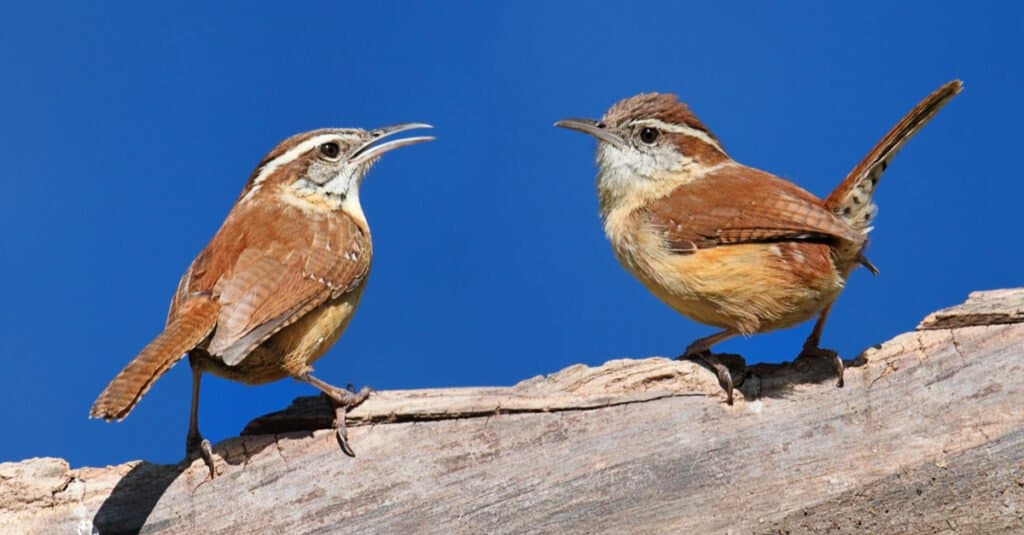The official state bird of South Carolina is the Carolina wren! Its Latin name, Thryothorus ludovicianus, means “reed-jumper of Louisiana.” Also known as the great Carolina wren, it was adopted as South Carolina‘s state bird in 1949, replacing the mockingbird.
What Does a Carolina Wren Look Like?

Male and female Carolina wrens are very similar, with males usually having longer wings and beaks.
©Steve Byland/Shutterstock.com
Both male and female Carolina wrens have bright, unpatterned, reddish-brown upperparts. Their underbellies are a warm, soft orange. Many birdwatchers identify this species by their signature white eyeliner and long white eyebrow stripe. Carolina wrens have a dark bill, with white around their chins and throats. They also often pose in a distinctive “tail-up” posture.
Females and males look so similar that it’s almost impossible for the casual observer to tell a female and a male Carolina wren apart. Males will often have longer beaks and wings, but the distinction is subtle.
What Does South Carolina’s State Bird Sound Like?
Bird watchers often report hearing this shy little bird before getting a glimpse of its cinnamon plumage. Carolina wrens deliver an impressive number of decibels for their small size. They are well known for their emphatic “teakettle, teakettle!” exclamations, and other melodies. They have a repertoire of up to 40 different songs!
Once you hear that signature tune, you will have no problem deciphering if the Carolina wren you are looking at is a male or female. Only the males sing. “Each male has a repertoire of up to several dozen different song variations. He’ll sing one of these about 15 times before changing his tune,” according to AllAboutBirds.org.
Listen to a Carolina wren sing!
Where Do Carolina Wrens Live?

Although they are called Carolina wrens, the species has a range as far north as southern Canada.
©Alexander Lukatskiy/Shutterstock.com
South Carolina’s state bird lives in the Palmetto State year-round. Carolina wrens, however, span far outside the state’s borders. These charismatic little songbirds sing their tea-kettle song from Mexico north to the mid-Atlantic states and west to eastern Nebraska.
Carolina wrens are also sometimes found as far north as southern Canada. As they are a nonmigratory species and accustomed to a milder climate, many Carolina wrens don’t make it through the cold winters in their more northern range.
What Do Carolina Wrens Eat?

Carolina wrens prefer a diet of insects but will also eat small lizards and tree frogs.
©Steve Byland/Shutterstock.com
These inquisitive and energetic songbirds are insectivores. They like to forage in pairs, as this species mates for life. Carolina wrens prefer a diet of caterpillars, grasshoppers, beetles, spiders, and even small lizards or tree frogs. They also enjoy berries and seeds, especially in winter.
Especially in their northern range, California wrens need all the help they can get to survive the harsh winter. “Although sunflower seeds might attract more colorful birds, Carolina Wrens generally prefer suet and peanuts. One peanut alone can provide more than a third of their daily metabolic need!” according to Cornell Lab’s Project Feeder Watch.
The photo featured at the top of this post is © A-Z-Animals.com/A-Z Animals
Thank you for reading! Have some feedback for us? Contact the AZ Animals editorial team.







